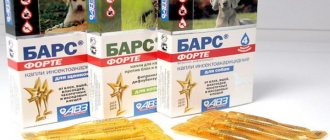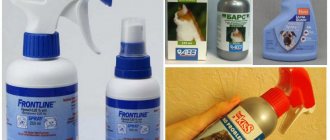If you decide to remove fleas from your cat, first of all you need to draw up a plan to combat adult insects and their eggs. The most effective are: drops, injections and flea collars. They have a strong and long-lasting effect, turning the cat into a biological weapon to combat fleas.
The mechanism of action is quite simple: a substance enters the blood of a kitten or cat that is poisonous for fleas and does not harm the cat itself. Having bitten a cat, a flea receives a lethal dose of poison, in addition, new generations of fleas hatched from eggs will also be poisoned. Thus, you are guaranteed to rid your cat or kitten of fleas for a long period of time.
As a rule, to get rid of fleas from a cat, you need to start with a thorough cleaning of the room.
How to protect your cat from fleas and ticks: basic methods
A cat, especially an outdoor one, must be treated for parasites, even if they are not detected. Insecticidal preparations will repel pests from the animal. If the parasites do attack the cat, they will die as soon as they attach themselves to the pet. The effectiveness and duration of protection largely depends on the product with which the cat will be treated.
To help remove fleas from a cat at home:
- collars;
- drops;
- solutions;
- sprays;
- shampoos;
- powders/powders;
- pills;
- injections.
Flea and tick collar for cats
Collars for cats are primarily designed for fleas. Before purchasing, read the instructions to know exactly how the flea collar for cats works:
- Some models only repel insects.
- More advanced options kill parasites by distributing the active substance throughout the animal's body.
- Among the models, there are those that destroy only adult individuals, while others cope with parasites at earlier stages.
Important: Even the best flea collars for cats often cause allergies. If your pet wears it for a long time, but does not stop itching, remove the accessory and replace it with another drug.
Drops on the withers, solutions, sprays against fleas and ticks for cats
Sprays and drops against ticks for cats provide good protection. They contain an active substance that is distributed along the skin but does not enter the blood. The solution repels parasites, especially at first, while there is a smell. Then the aroma goes away, the pests attack the animal and die when they bite through the skin.
For the drug to have the desired effect, the pet should not be washed 3 days before and after treating cats for fleas and ticks. It is also important to apply it not to the fur, but to the skin of the cat. To prevent the animal from licking the solution, it should be dripped onto the withers.
The spray can be used to treat a cat's bedding against fleas and ticks. This way the pet will be more reliably protected.
Shampoos
Flea and tick shampoos for cats will help get rid of parasites, but they are effective for no longer than 3 days. But they can be used as comprehensive protection. For example, a cat can be washed with shampoo 4-5 days after treatment with tick drops for cats. The product will wash away dead parasites and soothe irritated skin.
Tablets and injections
Tablets boast the longest and most effective action. The price of flea treatment for cats is high, but justified. The tablets do not repel parasites, but cause paralysis as soon as they bite through the skin. After a few hours the pest dies. For this reason, the tick does not have time to release saliva into the bloodstream and infect the cat.
Important: never give cats tablets for dogs, even if you calculate the dosage correctly. Buy only medications designed specifically for cats.
In the apartment
To prevent fleas from returning to their favorite place in your pet’s fluffy fur, it is necessary to disinfect the entire apartment.
Professional pest control
The most effective method is temperature treatment of housing using a heat gun. The pest control team will assess how infested the apartment is and, in accordance with this, will choose a method for exterminating the insects. All you need to do is prepare your home for the arrival of specialists and pay for their services. Don’t be alarmed if fleas appear in your apartment again after a few days. Surely their eggs or larvae remained in the deep crevices. They will not survive contact with treated surfaces. This phenomenon can last up to 4-5 weeks, after which the insects will leave you alone.
Self-processing
If you do not have the opportunity or desire to use the services of professionals, you can disinfect the apartment yourself. For this purpose you will need an insecticidal spray or powder.
Aerosol treatment
- Before you begin disinfection, remove all living things from the apartment: children and adults, except for your assistants, animals, birds, aquarium fish and indoor plants.
- Throw out the trash in advance and get rid of unnecessary things.
- Move furniture away from the walls. If there is a rug hanging on the wall, remove it.
- Treat all items in the apartment with the selected aerosol, including upholstered furniture, clothes, shoes, and bed linen. Try to get the drug into every crevice.
- Close windows and doors tightly and leave your home for several hours - preferably overnight. The next day, ventilate the apartment properly, wash and wash everything that has been treated.
Powder treatment
Unlike aerosols, powdered insecticides are less effective. You will have to wait much longer for the desired result. But you don’t have to leave your apartment. Powders are poured in places where fleas are most concentrated: behind baseboards, in corners, in hard-to-reach crevices. Upon contact with the powder, not only eggs and larvae, but also adult insects die.
How to protect your cat from fleas
Insects can end up on your pet, even if it has not been in contact with other cats. If the cat is outdoor, the parasite can jump onto the fur from the grass or asphalt. If the pet has never left the apartment, infection is possible from other pets (cat, dog) that are outdoors.
The Best Flea Treatments for Cats
To protect your cat, you can use drops, tablets, and shampoos. It is very important to regularly treat the bedding on which your pet sleeps with a flea spray for cats and wash it constantly.
Flea and tick collar for cats: which one is better?
Good results in protection against fleas and ticks were shown by:
- Beafar Flea & Tick collar;
- Preventeff Cat (Virbak);
- Foresto (Bayer/Elanco).
If you want the most effective flea treatment for cats, containing natural ingredients, buy collars from the Celandine series.
Anti-tick tablets for cats
The best protection for cats against fleas and ticks in the countryside is Inspector Quadro tablets. They protect the cat from parasites for 2 months.
Drops and sprays
The price of anti-tick drops for cats is cheaper than tablets, but they do not last as long - 2-3 weeks. According to reviews, the best flea drops for cats:
- Bravecto Spot On;
- Beafar;
- Inspector;
- Advocate;
- Frontline.
Shampoos
Among the shampoos, Bio from Beafar, Pchelodar from Agroprioprom, and Antiparasitic Celandine have proven themselves well. If you need a “2 in 1” product, you can buy a spray:
- Fiprist spray;
- Parastop from Virbak;
- Fiprex spray forte (Vetagro).
Powder
To protect against fleas, you can use a special powder / powder (Flicar, Ektosan, Insectal). This method is not popular, but this does not mean that it is bad. The powder is applied to dry fur, then rubbed into the skin. The powder is absorbed into the top layer of skin and protects against fleas.
Reviews
Svetlana: Bars drops helped my cat get rid of fleas. They were recommended to us by a veterinarian whom we contacted after discovering fleas. You drop it and you can live in peace for two months.
Evgeniy: We regularly buy a Hearts collar for our cat. The result is impressive - fleas do not bother the animal or us. And this despite the fact that we spend the whole summer at the dacha, where the cat walks on its own.
Nina: Our cat loves to walk outside, and in the basement of the house there are cats infested with fleas. From time to time I use flea shampoo. For preventive purposes, in addition to Rolf Club shampoo, I regularly bathe the cat in a decoction of tansy and wormwood, after which I comb out the hair. Fleas don't bother my pet!
How to protect your cat from ticks
To protect your cat from ticks, you can use the same products as against fleas, but more often. For example, if drops protect against fleas for 3 weeks, against ticks – for two.
Don't forget to examine your pet every time she comes home from the street. If you remove the parasite in time, the chance of avoiding infection increases significantly. Since the tick does not attach itself immediately, look not only for arthropods swollen with blood, but also for those that are only crawling along the fur.
The best tick repellents for cats
If your cat is always outdoors, give preference to Inspector Quadro tablets, which provide protection for 2 months. They help especially well if your pet has demodicosis. The pills do not completely cure the disease, but while they work, they reliably curb population growth.
Analogue tablets - injections (Ivermek), Eprimek, Lufenuron. They protect not only from insects, but also helminths. However, these are very strong drugs that have a toxic effect on the body. Therefore, veterinarians rarely prescribe them, in very severe cases.
If you are worried about safety, or are afraid of poisoning your cat, take Bravecto Spot On drops, Beakar. They provide good protection against ticks, but your pet will have to be treated every 2 weeks.
How to remove a tick
If you see a tick on a cat, do not panic and do not pull it out. If you remove it incorrectly, the parasite may have time to release saliva containing the infection into the blood. Also, its head will remain in the cat's body, which can lead to suppuration.
Veterinarians recommend using a special device to remove the parasite. If you don’t have it, you can use tweezers, or, as a last resort, eyebrow tweezers:
- Grasp the tick with tweezers as close to the skin as possible.
- Gently twist the forceps to gently pull out the parasite.
- Turn only one way. Do not loosen the tongs or pull the tick sharply upward. You can tear it, and part of the parasite will remain in the skin, or out of fear it will have time to inject saliva.
Signs of infection
A flea may begin to bite a cat from the first day of infection, but it is difficult for a person to detect its presence. But when the offspring of the first flea grows up, a colony of parasites forms. They will lead to the appearance of symptoms, a person cannot help but pay attention to this. The main symptom is that the cat will itch intensely. Cats living outside, feeding their flea parasites for years, may not pay attention to the bites, but an indoor cat with delicate, well-groomed skin can itch until it bleeds. When bitten, some cats flinch or bite into the fur (or directly into the skin).
In places where severe scratching occurs, sores appear that become wet or bleed. They will not be able to heal quickly, as the cat will continue to itch. In addition, insect excrement (small black particles) will appear on the cat's fur. If fleas have appeared for a long time, the fur may become thinner, fistulas, abscesses or allergic dermatitis may appear.
Photo gallery: symptoms of flea infestation
When you try hard to scratch an itchy area, small sores appear first.
To see flea excrement on a cat's fur, you need to slightly part the fur with your fingers, creating a parting.
An abscess is a bulging purulent abscess (when it “bursts”, a fistula appears - a hole in the skin)
With allergic dermatitis, the entire body is covered with red spots (they are easiest to see on the stomach)
Why fleas are dangerous for animals and humans
In addition to skin problems caused by flea bites, your cat may also develop other parasites. A cat that licks fur or itchy skin swallows fleas whole. An insect may contain larvae of worms, etc. Thus, both a cat and its owner can become ill with helminthiasis. And if the worms then pass to a small kitten, then the helminthic infestation can lead to the death of the pet. In addition, advanced infestation with parasitic insects can lead to anemia (anemia) in the animal.
The cat owner faces more than just infection with worms. Of course, a flea cannot live permanently on the human body, but even one bite can lead to trouble. Fleas are carriers of diseases of the blood and lymph (for example, erythrema, a lesion of the lymphatic system that leads to severe inflammation of the skin). You can also become infected with pulicosis (a very itchy rash all over the body) through a flea bite. After this disease, scars remain on the skin that do not heal even with time.
If the cat begins to feel unwell, and later one of the household members joins it, then it may be dipilidiasis. Symptoms of this disease are weakness, nausea, and vomiting. This disease affects the organs of the digestive system, hence the symptoms, like intoxication. Another danger is brucellosis (symptoms: high fever, aches, joint pain, sweating). Of course, if it comes to such serious symptoms, then you need to urgently consult a doctor, and the cat needs to be taken to a veterinarian.
If the owner of a cat is bitten by a flea, and later unpleasant symptoms appear, an urgent need to consult a doctor
How to protect your kitten from fleas and ticks
Most products are intended for kittens from 8 weeks of age. Unless absolutely necessary, do not use insecticidal preparations that are not age appropriate. They contain strong ingredients that can be harmful.
If you find parasites, you must wash or change the bedding and wash the floor in the apartment using disinfectants. You can try combing fleas out of the fur, but the procedure will not bring much effect.
To protect your kitten you can use:
- from 2 days of age: Fipronil Spray;
- from 7 days: Fiprist Spray;
- from 1 month of age: Frontline spray;
- from 6 weeks: BEAFAR SOS collar.
Before purchasing a product, it is important to make sure that it is safe not only for the baby, but also for the mother. Apply flea and tick medication for cats only to areas specified in the instructions. By licking the kitten, the mother can lick off the solution.
Features of the insect
Fleas in cats
Cat fleas are wingless, blood-sucking insects that live in the animal's fur. They have a specially designed mouthparts, with which they bite through the cat’s skin and suck blood from the wound. A high degree of mobility is ensured by a laterally flattened body and long hind legs. The flea moves briskly among cat fur thanks to its head, rounded at the front. The body of the parasite is covered with bristles and spines, making it easier for it to move.
How to protect a pregnant and nursing cat from fleas and ticks
Ideally, the animal should be treated before pregnancy. But flea treatments for cats on the withers last no more than a month; you will still have to use such a drug once.
It is highly undesirable to use tablets during pregnancy and lactation, as they can affect the formation of the internal organs of kittens. This must be taken into account, even if the manufacturer claims otherwise. It is better to take drops and sprays that are not absorbed into the blood.
As for nursing mothers, it is better not to treat them at all, since kittens can lick the spray from their fur. To protect your cat, simply do not let it out of the house, protect it from contact with other pets, and clean the apartment thoroughly.
Anti-flea collars
One of the most popular remedies for animals that “walk on their own.” Collars such as “Barrier” or “Beafar” retain their properties for up to five months. There is no need to worry that your pet will be uncomfortable in the collar: full adaptation takes no more than one or two days, even for adult animals that have never worn a collar before.
The negative points include the following:
- presence of a specific odor;
- Sometimes the hair on the animal's withers thins.
Collars are produced for adult animals and kittens.
How to Protect Your Older Cat from Fleas and Ticks
Flea and tick treatment for older cats should not be ignored. Over the years, immunity declines and succumbs to infections that the body used to cope with on its own - Lyme disease, encephalitis, dermatitis. Treatment is difficult, and an older pet can die.
The same products are suitable for treating an old cat as for a young cat. Instead of tablets and injections, it is better to use drops on the withers against ticks for cats. They are safe and do not harm internal organs, which is very important in old age, when many systems in the body fail.
When choosing the best tick repellent for cats, consider the following recommendations:
- Health. If your pet is weak, buy a tick collar for cats or drops.
- Allergy. Over the years, immunity declines, which can manifest itself as allergies. Change your cat's anti-tick medications if a reaction occurs to a product that previously had no problems. To get rid of the effects of allergies, give your cat a bath.
- Age. The older the cat, the gentler the effect on the body should be.
If you want to give a flea tablet to cats but are not sure, talk to your veterinarian. He will take blood tests and do allergy tests that will determine if it is safe to give flea medication to cats.
Folk remedy for ticks and fleas for cats
In terms of effectiveness, folk remedies for fleas for cats are significantly inferior to insecticides, and are not always safe. For example, washing with gasoline or alcohol will not bring any benefit. They will only temporarily stun the parasites. When the pests wake up, they will continue to torment the cat.
If you still want to use traditional methods, try essential oils. To repel fleas, take wormwood oil, ticks - cedar. These aromas may frighten pests, but will have no effect if the parasites are too hungry (for example, in early spring).
Important: not all scents are suitable for cats. For example, orange repels fleas, but cats do not like them, just like any other citrus smell. The same goes for geranium, eucalyptus, and lavender.
id=»u»>Can drops be used to treat a room?
No you can not. To treat the premises, special preparations containing a higher concentration of chemicals should be used. Due to their toxicity, during spraying it is necessary to use personal protective equipment (mask, gloves, goggles), and take household members and pets outside. If parasites have spread throughout the house, the algorithm of action should be as follows: treatment of the pet until complete recovery - sanitization of the premises - repeated sanitization.
Recommendations
To prevent your pet from becoming infected with fleas and ticks, follow these recommendations:
- Before treating your cat for fleas and ticks, read the instructions carefully.
- Follow the animal treatment schedule indicated in the instructions for the product you have chosen.
- Select the dosage based on the weight, age, and health of the animal.
- Regularly treat the bed where your pet sleeps with an anti-tick spray for cats.
- Vacuum frequently, paying special attention to areas where your pet likes to spend time. The vacuum cleaner bag can be treated with flea spray to kill live fleas or eggs that are sucked inside.
- Use only one product per treatment. The chemicals in different products don't always work well together and can be harmful to your kitten.
- A few days after using flea drops for cats, bathe your cat with shampoo to remove dead insects.
There are many insecticidal products on the market that effectively kill fleas and ticks. The main thing is not to buy the product secondhand, so as not to take a fake. Take drops, tablets, sprays only from veterinary pharmacies or pet stores.










